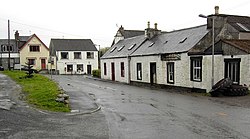Balmaclellan
Balmaclellan
|
|
|---|---|
 Balmaclellan |
|
| Balmaclellan shown within Dumfries and Galloway | |
| Council area | |
| Lieutenancy area | |
| Country | Scotland |
| Sovereign state | United Kingdom |
| Police | Scottish |
| Fire | Scottish |
| Ambulance | Scottish |
| EU Parliament | Scotland |
| UK Parliament | |
| Scottish Parliament | |
Balmaclellan (Scottish Gaelic: Baile MhicIllFhaolain, meaning town of the MacLellans) is a small hillside village of stone houses with slate roofs in a fold of the Galloway hills in south-west Scotland. To the west, across the Ken River, the larger and more prosperous New Galloway lies below the Rhinns of Kells.
Balmaclellan is one of four parishes in the northern district of the Stewartry of Kirkcudbright. It contains 23,737 acres (96.1 km2), of which about 4,000 acres (16 km2) are cultivated. It includes areas of water, extensive plains of moss and about 300 acres (1.2 km2) of tree plantation, but most of the land is used for sheep or cattle pasture. Many of the cattle are of the Galloway breed. The climate is temperate. Average monthly temperatures range from 1 to 7 C° in January, and 11 to 18 °C in July–August, with 984 mm of rain yearly.
In 1887, John Bartholomew's "Gazetteer of the British Isles" Described the inhabitants as "... of a mixed Gaelic and Germanic origin, and speak Braid Scots, a Northumbrian dialect of English. Those that profess a religion are generally but by no means entirely Calvinist Christians, adhering to the Church of Scotland or the Wee Frees". In 2009, of those who profess a religion in Balmaclellan most are Presbyterians adhering to the Church of Scotland.
The population was 554 in 1801, 634 in 1901 and 550 in 1951.
Celtic relics have been found in the area, including a finely decorated mirror and crescent of the Bronze Age that is now in the National Museum of Scotland. The parish of Balmaclellan appears to have had an earlier British name, Treuercarcou, which appears in a thirteenth-century record of ecclesiastical taxes. The treu- part of this name is clearly the old northern British equivalent of modern Welsh tref, 'farmstead, dwelling', indicating an early settlement when this P-Celtic language was still spoken in the area.
...
Wikipedia

